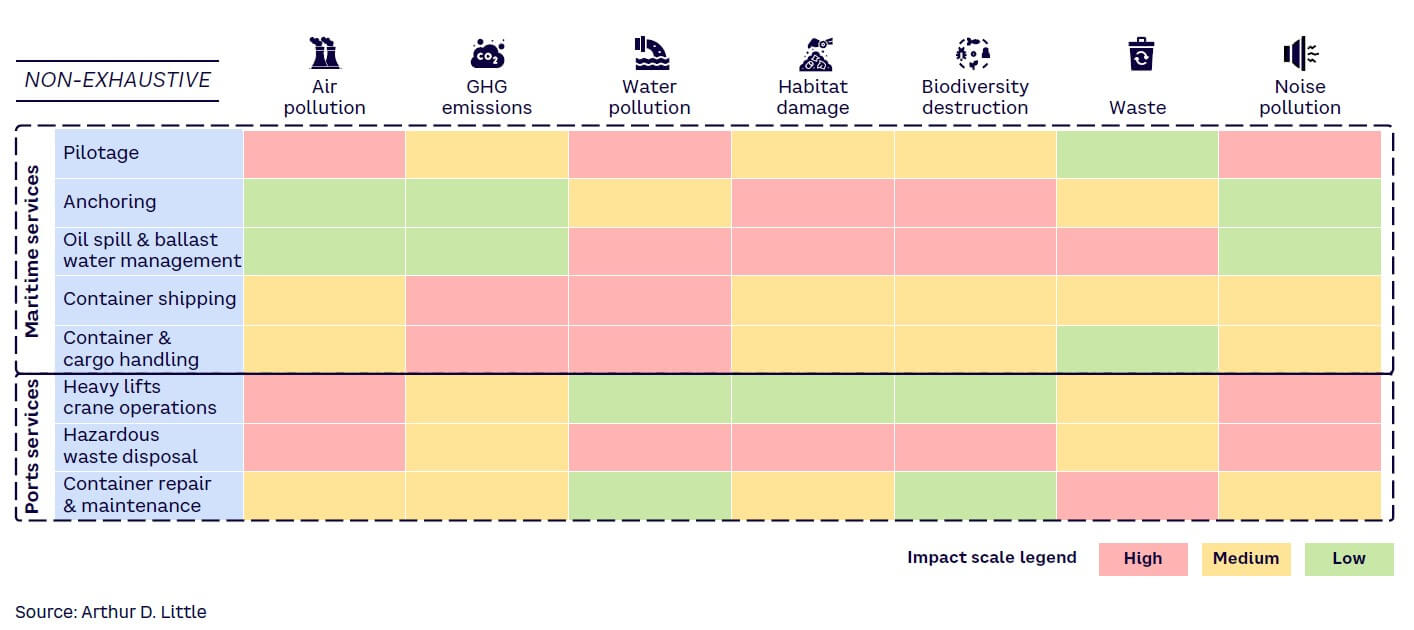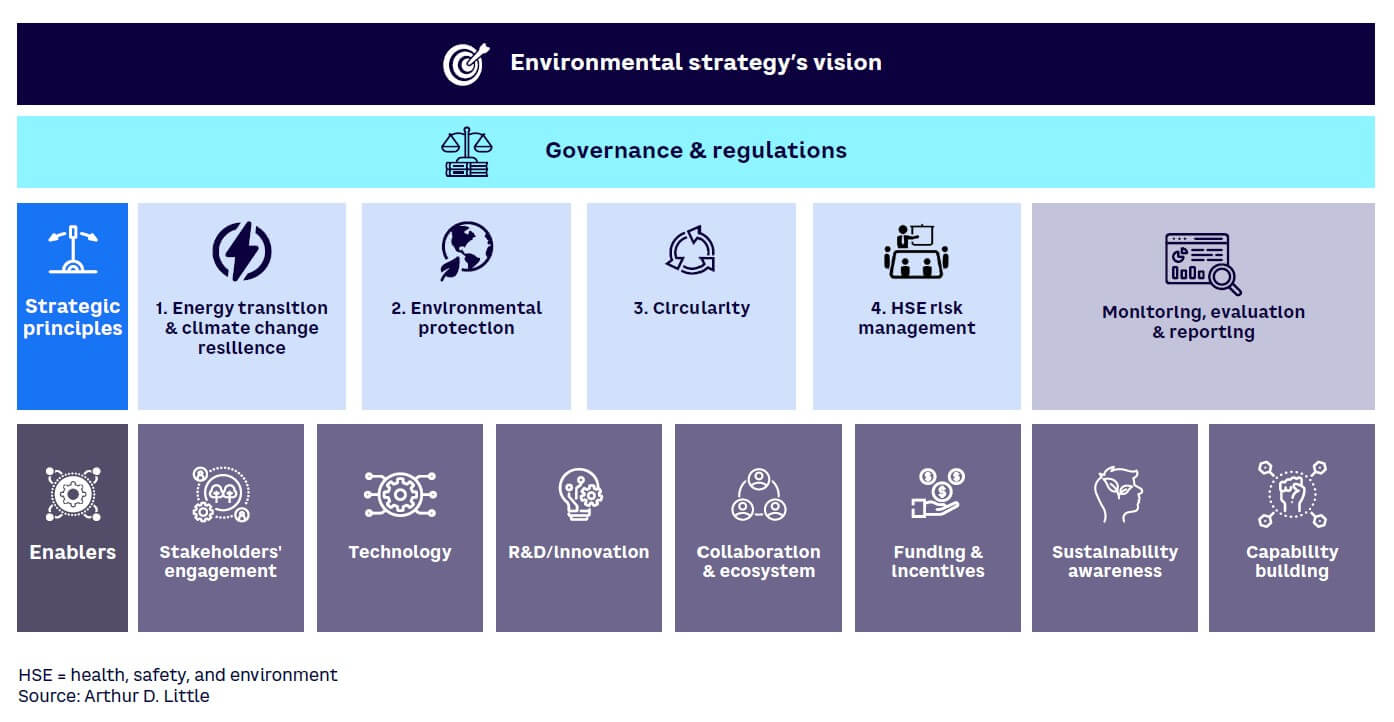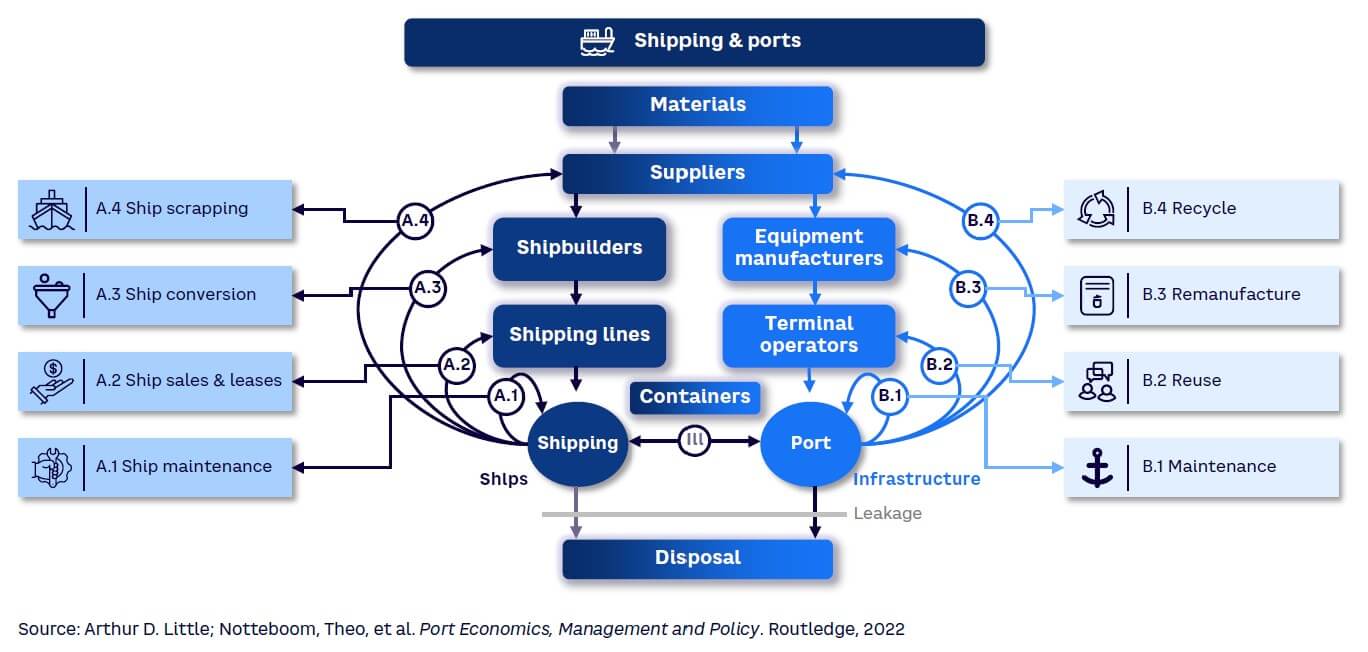
Of the top five issues impacting the port and maritime industry, three relate to environmental risks — a position that has not changed over the last five years. The sector must therefore drive the decarbonization of shipping, comply with increasing environmental regulations, and meet societal demands for greater sustainability. These efforts require an ecosystem approach, with ports and maritime operators playing a pivotal role in creating the blue economy and delivering a sustainable future.
SUPPORTING ENVIRONMENTAL PUSH ACROSS GLOBAL ECONOMY
According to the United Nations Conference on Trade and Development (UNCTAD), ports and the wider maritime industry are responsible for more than 80% of world trade, making them central to the success of the global economy. Their activities connect supply chains; transport goods, commodities, and raw materials around the world; and support industrial and storage facilities. The sector therefore affects the daily lives and operations of most consumers and businesses. Three key drivers are impacting the sector as it embraces environmental change:
-
Net-zero shipping catalyzing the green transition. Shipping faces a growing number of specific regulations designed to reduce emissions and make it more sustainable. For example, many regions have introduced or plan to introduce International Maritime Organization (IMO) Emission Control Areas (ECAs), which mandate that vessels use fuel with sulfur content below 0.1%. However, greenhouse gas (GHG) emissions from the world’s maritime fleet increased by 23% from 2012 to 2022 and then 4.7% between 2020 and 2021. Per ADL analysis, we forecast it to rise by 44% by 2050 if countermeasures are not put in place. Thus, there is an urgent requirement to reduce emissions through greater efficiency and the introduction of lower-carbon fuels.
This requirement will soon be mandatory in the EU, where the Alternative Fuels Infrastructure Regulation (AFIR) and FuelEU Maritime (which have recently become laws) will push both the provisioning of shore-side electricity and the phase out of all powertrain technologies that cannot ensure zero GHG emissions, promoting the adoption of renewable fuels of non-biological origin (RFNBO), such as methanol, ammonia, and synthetic fuels. Some shipping lines have already launched their sustainable fuel strategies, ordering methanol-powered vessels, for example. (A specific in-depth study on this topic will be presented in an upcoming Viewpoint.)
-
A global coalition with tighter regulations pushing the green transition. UN Sustainable Development Goal 14, “Life Below Water,” sets 10 targets and 10 indicators to measure the health of the seas, including around pollution, ocean acidification, and marine ecosystem protection/restoration. The aim of improving the marine environment has been accelerated by the UN High Seas Treaty, signed in March 2023. The most far-reaching treaty since the Paris Agreement of 2015, it provides a comprehensive legal framework to conserve and manage marine species in the 90% of the ocean outside territorial waters. It will increase pressure on the maritime sector to become more sustainable across its operations, especially in extraterritorial waters.
-
Sustainability at the heart of customer demands. Consumers are demanding greater sustainability from the companies they buy from — across those companies’ entire supply chains. This is being translated into business commitments around achieving net zero and demonstrating ethical behavior across the entire supply chain. In turn, these businesses are putting pressure on the maritime industry that transports their goods. For example, the Cargo Owners for Zero Emission Vessels (coZEV) initiative, which has members that include Amazon, Michelin, DuPont, Unilever, Inditex, and Philips, has pledged to use solely zero-emission shipping by 2040. This accelerates the need to decarbonize maritime transport or else face the loss of major cargos.
According to the World Economic Forum, six out of the 10 global top risks in the next 10 years will relate to environmental issues. Therefore, ports and maritime stakeholders must enhance collaboration to effectively tackle the most relevant environmental risks:
-
Biodiversity. Without action, over 50% of the world’s maritime species could be on the brink of extinction by 2100 according to the UN Educational, Scientific and Cultural Organization (UNESCO).
-
Pollution from both plastic and chemicals. Based on World Wildlife Fund figures, by 2050 there will be more plastic than fish in the ocean by weight.
-
Natural resource depletion. Mankind currently uses 1.8x the biological resources that the earth generates every year, leading to environmental degradation of the blue economy.
-
Livability of coastal areas. Many ports and coastal areas are at risk of becoming uninhabitable due to global warming, erosion, and extreme weather.
-
Noise pollution from marine vessels. Internally, noise pollution impacts crews, and externally, disrupts communities and endangers wildlife.
Many of these issues are exacerbated by the tragedy of the commons — the fact that the vast majority of the planet’s oceans are outside national jurisdictions and are therefore not owned by a single state. For the first time, the High Seas Treaty changes this.
The emerging concept of the blue economy (see sidebar) is reinforcing the need for change and encouraging the sustainable use of ocean or “blue” resources for economic growth, improving livelihoods and jobs while preserving the health of ocean ecosystems. Like the green economy, the blue economy aims to bring human well-being, social equity, and environmental sustainability into harmony. Achieving this requires a combined private/public sector approach that drives collaboration to understand and manage ocean resources in a sustainable way for the good of all. As hubs for maritime transport, food, energy, raw materials, and tourism, the ports and maritime sector must be a pivotal part of the blue economy.

UNDERSTANDING ENVIRONMENTAL IMPACT
Ports and maritime operations have a significant and growing environmental impact across a range of areas, as shown in Figure 1. These include air pollution, GHG emissions, releases of ballast water containing aquatic invasive species impacting biodiversity, oil/chemical and cargo spills, underwater noise pollution, ship strikes on marine animals, the release of sewage and other waste, increased sedimentation, and habitat damage caused by accidents or collisions, such as with coral reefs.

Decarbonizing the shipping industry requires a range of actions, particularly from port and maritime governing authorities. It should start with a collective effort toward harmonizing regulatory carbon-accounting standards and frameworks across the globe and then covering the introduction and financing of innovative technologies to deliver transformative change to maritime transport.
Ports face their own challenges and opportunities when it comes to the environment. They are the pivot for the blue economy and act at the interface between the land and sea. As such, they are central to creating net-zero transport and logistics nodes and must become catalysts for the green transition by reinvention as renewable energy hubs for shipping, port activities, and surrounding industries. They must take a key role in building and driving the circular economy (e.g., managing the scrappage and recycling of ships).
Moving forward, ports face increasing pressure on their resources and therefore must be managed in a strategic, sustainable way across all their activities. Understanding this, the European Sea Ports Organisation (ESPO) has defined two pillars within its reference framework to enable and support a sustainable port ecosystem, including:
-
Pillar 1 — reducing pollution and other externalities; for example, becoming net-zero emitters by 2030
-
Pillar 2 — through partnership and collaboration, introduce new solutions that enable ports to become engines of the green transition
TAKING ACTION TO DELIVER CHANGE
The ports and maritime sector spans a wide range of players, from shipping companies and their customers to port and maritime operators, shipbuilders/maintainers, local industry, workers, associated businesses, governments, and regulators. Successful sustainability requires joined-up, collaborative action under a single cohesive vision, integrating objectives and related standards in an ecosystem approach to accelerate lasting change to safeguard a more sustainable, diverse, and livable net-zero environment.
Ports and maritime governing authorities must leverage their pivotal role in influencing the sector, pushing and supporting all stakeholders in the development and integration of their sustainability strategies, synchronizing their implementation in order to enhance collaboration, and coordinate development through a roadmap of initiatives and projects across four key strategic principles supported by a variety of enablers (see Figure 2).

Each of the four strategic principles is a key dimension to ensure the long-term success of ports and maritime organizations’ environmental strategies.
1. Energy transition & climate change resilience
The energy transition for climate change resilience is the sector’s highest priority. Organizations must focus on renewable energy for port and maritime activities and enable local industrial activities to do the same, evaluating the growing range of clean power-generation sources and sustainable fuel options for shipping, based on factors such as:
-
Emission-reduction potential
-
Potential supply and availability
-
Energy density
-
Infrastructure compatibility
-
Safety requirements
-
Storage and transportation requirements
These evaluations will enable participants to select the optimal mix for their own activities as well as for the wider ports, maritime, and industrial ecosystems.
For example, the Rotterdam Port Authority in the Netherlands is working with partners to introduce a large-scale hydrogen network across the city’s port complex, making it an international hub for hydrogen production, import, application, and transport to other countries in Northwest Europe.
The ambition is to produce 20 metric tons (Mt) of climate-neutral hydrogen by 2050 — which will require over 100 GW of electrolysis capacity and over 200 GW of electricity generation from renewable sources (mostly offshore wind) due to their intermittent availability.
Energy transition will be the key intervention to reduce ports’ and the maritime sector’s GHG footprint and to support global efforts to limit the impacts of climate change. However, ports and maritime operators must develop solid climate change–resilience plans to be ready to prevent and mitigate related impacts on their business continuity.
2. Environmental protection
Governments, regulators, and authorities are gradually increasing environmental-protection requirements, while many stakeholders are pushing ports and maritime operators to be more transparent and effective in mitigating their environmental impacts. Ports and maritime governing authorities must promote and support collaboration within the sector ecosystem to define and jointly manage initiatives for air pollution and dust emissions mitigation, the improvement of water and soil quality, the reduction of noise, and the protection of habitats and biodiversity.
3. Circularity
Port and maritime governing authorities must support the sector in embracing the greater use of innovative technologies to enhance waste and water circularity, thus improving energy and materials efficiency. Options include incentives to promote:
-
Carbon capture, utilization, and storage — supported, for example, by plant cultivation such as algae, which have a higher photosynthesis rate compared to terrestrial plants
-
Chemical recycling — leveraging the presence of various chemicals firms and technologies typically located near ports
-
Energy from waste — often used in connection with district heating solutions, which can support decarbonization of coastal communities
Finally, among the most relevant actions required by the sector is the greater use of innovative, advanced materials to reduce the weight and energy use of vessels, prolong their life, and improve safety. Options include:
-
Graphene-doped anti-corrosion coatings — to improve hydrodynamic efficiency
-
High-strength, self-healing structural materials — to reduce maintenance costs
-
Self-cleaning/self-repairing finishes — to increase material lifespan and reduce chemical use
-
Bio-based materials — to increase overall supply chain sustainability and reduce production emissions
Circularity can become a value generator for all players in the ecosystem while meeting environmental goals. For example, as reported by World Maritime University, a cost-benefit analysis of a circular model initiative proposed for the Copenhagen-Malmö port showed that, against an investment of around $49 million for installation and maintenance of a new biogas power plant and cold ironing system, there will be a payback period of about seven years, showing the feasibility of the proposed model, which will also generate positive externalities for nearby communities.
Port and maritime governing authorities must facilitate the sector to bring together shipping and ports operators in a single, closed-loop ecosystem based on the four principles of maintenance, reuse, remanufacture, and recycle (see Figure 3).

Demonstrating the drive for circularity, the European Institute of Innovation & Technology’s (EIT) LOOP-Ports project aimed to drive a transition toward closed-loop systems by creating a circular economy network of European ports. It focused on materials (e.g., metals, plastics, and cements) with a high environmental impact, identifying opportunities for change through innovation, collaboration, and stakeholder interaction. The LOOP-Ports project involved more than 40 partners from six EU member states.
4. HSE risk management
The sector is characterized by a combination of internal health, safety, and environment (HSE) hazards and risks connected to cascading impacts of HSE hazards from the industrial facilities that typically exist near ports and coastal areas, including refineries, petrochemical plants, power-generation plants, and steel and manufacturing factories. All port and maritime actors must therefore ensure they have a clear understanding of their exposure to HSE risks by defining initiatives to ensure a state-of-the-art approach toward hazard identification and risk assessment within the port and maritime ecosystem. These initiatives will be the foundation of both risk-prevention and emergency management activities and should be supported by a strong collaboration with partners and peers at global scale.
Port and maritime governing authorities must create a framework collecting HSE risk assessment from different operators within the sector, verifying their consistency and making sure there are no “gray areas” that could potentially lead to unknown and unmitigated HSE risks.
Enabler example — Technology, R&D & innovation
Port and maritime governing authorities must promote the delivery of projects and initiatives across the four strategic pillars, supporting the deployment of the enablers shown in Figure 2, among which technology and R&D/innovation may have the most immediate impact.
For example, facilitating and supporting the upgrading of IT infrastructure and rolling out technologies such as 5G, Internet of Things, artificial intelligence, and digital twins can assist the sector in retrieving and process data in real time, thus ensuring:
-
More precise container tracking
-
Engine condition monitoring
-
Preventative inspection and maintenance
-
Cost optimization
-
More accurate communication and navigation
Introducing automation enhances operating efficiency, increases security, and reduces costs; for example, through autonomous cargo ships and the integration of robotics into cargo operations, such as for ship inspections, firefighting, cleaning, and anti-piracy operations.
The Italian Port of Livorno is piloting 5G to transform its processes and support greater sustainability. The network will enable the port to use always-connected sensors and enhanced applications that control and make decisions in real time, to provide intelligent, real-time insights into operations and uncover opportunities for further optimization.
CASE STUDIES
Top 10 global transportation/shipping company
A major global shipping company recently sought to improve its performance in several environmental sustainability areas, including:
-
Setting sustainability targets based on factors such as regulations, competitor activities, customer requirements, technology feasibility, and emission simulations
-
Defining overall sustainability strategy toward the 2050 net-zero target, covering activity streams such as an alternative fuel feasibility study and technology and investment roadmaps around fleet portfolio and impact on partnerships
-
Creating a green fund and conducting an initial assessment of project priorities and investments
-
Developing sustainability reporting and GHG emission inventory certification
-
Deploying a new sustainability organization, including recruiting senior leaders
Smart Delta Resources
Smart Delta Resources (SDR) is a unique, cross-border collaboration of industry, port, governments, knowledge institutions, and energy and network companies in the Flemish-Dutch Scheldt-Delta region. Partners include North Sea Port, DFDS Seaways, Yara, Zeeland Refinery, Vopak, Dow Benelux, ArcelorMittal, Engie Electrabel, PZEM, and Ørsted. The objective is to investigate making significant reductions in their use of energy and feedstock, achieving a CO2-neutral industry by 2050.
With the region home to the largest industrial hydrogen cluster in the Benelux Union, SDR’s Hydrogen Delta Programme aims to transition toward a low-carbon hydrogen economy, using offshore wind energy to power green hydrogen production through a number of planned and current electrolyzers. SDR is currently defining its green hydrogen ecosystem.
Nantes Saint-Nazaire Port ÉOLE project
Nantes Saint-Nazaire Port in France has launched the floating wind power‒generation project ÉOLE, identifying offshore wind power as a key lever for its future energy transition. The project is part of a national-level commitment to install offshore wind farms with 40 GW of installed power. The Northern Atlantic region of Nantes Saint-Nazaire Port is the most promising one for this technology, having an exploitable potential of 20-30 GW, corresponding to a total of some 1,500 wind turbines. Floating wind turbines will enable access to more constant winds found further offshore and limit the visual environment-related impacts and conflicts of use of maritime areas. At the port, floating wind turbines will require specific infrastructure to support construction and maintenance of installed assets. The ÉOLE project is part of the Nantes Saint-Nazaire Port’s goal of a successful energy and ecological transition and is receiving the contribution of the European Commission within the framework of the Connecting Europe Facility (CEF) program.
Rotterdam & ZEMBA — Fee reduction for green bunkering
Within the Zero Emission Maritime Buyers Alliance (ZEMBA) consortium framework, the Port of Rotterdam has decided to launch additional incentives to promote the adoption of sustainable shipping fuels. In particular, the port will offer a fee reduction to large oceangoing container vessels when bunkering sustainable fuels in Rotterdam, which can be a savings of as much as ~$542,000 for some larger vessels. To qualify for this discount, a vessel must bunker alternative fuels in Rotterdam with at least 90% reduction in GHG, such as green methanol or green ammonia. The coZEV — a platform specifically designed for climate-leading customers of the shipping industry — has also initiated a request for proposals for the transportation of 600,000 20-foot containers (TEUs) on oceangoing vessels powered by zero-emission fuels.
Conclusion
Pursuing a blue economy for a sustainable port & maritime sector
The port and maritime sector is a key driver of global trade and must play a pivotal role in creating and expanding the blue economy. Port and maritime governing authorities should act as facilitators in supporting the sector to:
-
Take a collective ecosystem approach across industries and players — at the local, regional, and global levels.
-
Develop and integrate sustainability strategies and synchronize resulting implementation roadmaps, enhancing collaboration to coordinate the development of the essential elements of a sustainability strategy.
-
Harmonize standards, especially around carbon accounting, and pilot and implement innovative solutions to unlock funding for change.
-
Focus on three key focus areas:
-
Clean energy for ports and shipping
-
Improved efficiency and greater circularity
-
Innovation and digitization to increase automation and the use of data
-
-
Jointly develop sector-tailored incentives such as fee reductions for operators adopting sustainable technologies.
-
Coordinate with local and national government bodies to define and deploy suitable incentive schemes that are required to boost and support the launch of sustainable investments.



